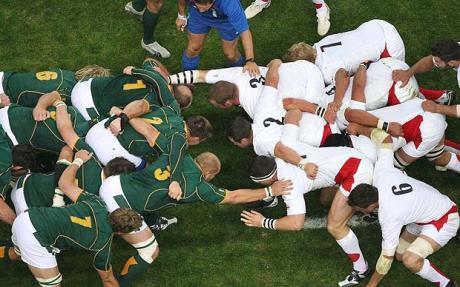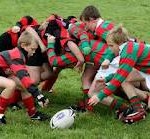A game played by men with odd-shaped balls, as the saying has it. Let’s start with the declaration of interest here: I attended a boy’s grammar school, where rugby was considered the gentlemanly game to play. The secondary modern school played common or garden soccer, you understand, and the preferences of students were irrelevant. Rugby did not interest me in the slightest, but I was forced to play it, along with hockey, lacrosse and other minority interests.
As a shy 11 year old, the physicality of rugby was intimidating but I gave it a go. For several matches in games sessions I got heavily buffeted but escaped with bruises, the worst critique being not that I did not get stuck in but that I didn’t have a clue what to do other than get rid of the pointy thing if it arrived in my arms. However, somehow I managed to score a try and was kept in the team.
In the final inter-form game, however, I was peacefully trotting forwards, eyes over on the far wing where a huddle of boys fought over the pointy object when something hit me in the head. Next thing I know, I’m on the deck looking at a grey sky with a pounding headache and people peering over me. Turns out an opposition player was doing something odd in the opposite direction and, he claimed, kneed me in the head while trying to jump out of the way. Sounds fishy to me, though I was too out for the count to care much at that point. Mild concussion diagnosed, I was allowed to dress and go home, and excused further rugby, ever again as it turns out.
This may help to explain my prejudice against the sport, but it was not for want of trying. My dad, bless him, often took me to rugby league games in my teenage years, and even RU format on occasions, not that I ever gained any huge enthusiasm. As time has gone on, my views on rugby have not mellowed, in spite of occasional viewings on TV, so this blog is merely an explanation. Doubtless the aficionados will come back with their own justification, but they will never convince me otherwise. So here we go:
1) Rules
Rugby is, according to the coaches and commentators alike a “technical sport”, by which they mean the rules are utterly incomprehensible – the Rugby Union would appear to be second only to speedway’s BSPA in terms of pointless rule tinkering – though those changes in recent years have included “bonus points” for tries scored, in a vain attempt to retain some modicum of interest where otherwise there would be none, and matches would be utterly forgettable. It failed, of course.
I once watched a rugby game with someone who has been a lifelong fan. When a penalty was given, the referee waved his arms around in a passable imitation of semaphore, and the defending players retreated, heads bowed. I asked my friend what the penalty was for. He simply shrugged his shoulders and admitted the truth: “I have no idea. You just have to accept that the refs know what they are doing.”
He went on to explain a selection of baffling rules, some of which made the football offside rule or cricket’s LBW laws seem like Janet & John by comparison. They all seemed to have a variety of provisos and exceptions which meant the ordinary fan had not a hope in hell of working out what was going on. For example, in the course of the same game I spotted a knock on (ie. ball travelling forwards out of control of the player.) Play did not stop.
Me: “Why was play not stopped when the ball was knocked forward?”
Friend: “The ball has to hit the ground.”
Me: “It did!”
Friend: “Oh! In that case, I don’t have a clue!”
2) Score inflation
It’s easy in football: a goal is a goal is a goal. In rugby the points vary: the Union code scores 5 for a try, 2 for a conversion and 3 for a penalty or drop goal, with the League code sticking to 4 for a try. First obvious question to ask is why they choose the points so that the minimum you can get for any sort of score is 3, to which the answer is equally obvious – artificially to inflate match scores to make it all look more interesting than it actually is!
3) Score priorities
Second question about scoring: if you are going to watch rugby, you presumably watch it for running rugby with tries scored. What actually happens for the majority of almost any match is that the action grinds to a halt due to a mystifying penalty decision of some sort, and for the next 3 minutes a player lines up a kick towards the sticks. Nobody from the opposition intervenes during this process, which is frankly dull as the proverbial ditchwater.
Then you watch American football (rugby with shoulder pads and quarterbacks), where they a touchdown (where nothing is actually touched down) scores 6 points and any kick 1 point. Oh, and the opposition can run towards the kicker during conversion equivalents. Whatever else you say about the American game, surely they have got the scoring right – set it so a running game is prioritised. Kicking where there is no intervention is pointless and uninteresting!
It is argued by critics that to reduce the value of kicks and increase try scores will simply result in teams giving away more penalties to prevent running rugby, to which my retort is obvious: reduce the number of infringements for which penalties can be given, play advantages and/or sin bin or send off players for “professional fouls.”
4) And talking of running rugby and dumb rules…
Rugby League is somewhat better in this respect than Union thanks to the 6 tackle rule, but running is not what happens. Lots of mucks and rauls (or whatever they are called), scrums and line outs, penalties and stoppages, but nothing remotely interesting to watch! Worse than that, the rules may give rise to lots of indecipherable penalties, but what players get away with seems worse. Didn’t hoisting a team mate up in a line out used to be illegal? Totally infuriating!
5) Spectating
I know a significant number of women go to watch rugby because they like to watch the players’ thighs (several have admitted as such to me), but there is simply nothing there worth watching. F1 and tennis are pretty dull to watch, but with rugby I can’t understand why anyone would choose to watch this tedious and inexplicable sport if they could, for example, write!
6) Value for Money
Football games last 90 minutes, rugby games only 80. This is commonly explained by the sheer physicality of rugby, such that the poor dears get tired and could not last out the extra 10 minutes, which for professional athletes is not an acceptable excuse. Clearly the gate prices should be at least 11% lower. Judging by ticket prices for the 2015 World Cup, stupid price inflation has hit rugby too.
7) Discipline
Here, rugby fans proudly proclaim, their sport is top dog. Players don’t argue with the refs, let alone crowd him. Any act of violence is punished by a spell in the sin bin (which in my humble opinion should be compulsory for many offences in football.) In fact, this sport is played by gentlemen who go off to get pissed in bars and sing rude songs together as soon as the match is over.
Except that is not the whole story. All manner of nasty things happen in rucks, mauls and scrums, and very few of them seem to get punished. You may hear about the odd eye-gouging and stamping incident, where they have been caught on TV, but what about all the blind-side punches, scrotum squeezes and all sorts of other unmentionables? They seem to be tolerated as “part of the game.” Don’t tell me they don’t go on – I’ll know you’re lying!
Ah, but they do have a system of “citing” players who allegedly did wicked things behind the ref’s back, though that is of little consolation to the player writhing around on the floor counting his tackle. So much for gentlemanly conduct… This is a vicious slugfest masquerading as a civilised form of entertainment.
Serious point here though: this is the sport where people can and do get paralysed for life as a result of particular types of “tackle” or because of scrum collapses. Don’t let anyone tell you it’s safe or that players behave in a better fashion than in other sports.
8) Injuries
So to continue this theme to its inevitable conclusions, ignore what you’ve heard about rugby being a sport played by gentlemen. It is a sport where, in spite of rule changes, terrible injuries occur on a daily basis, to concussion and way beyond. I’m not talking merely about fighting, stamping and other such petulant hooliganism either.
Scrums collapse causing fractured spines and paralysis; “up and over” tackles can do the same. Sending a player off or citing them is too late by that time – someone can be maimed for life with little or no compensation. More than that, players in the professional era are becoming bigger and stronger, such that repeated hits cause brain damage and a lifetime of suffering. As yet the sport has not cottoned on and is in total denial about this – ironic given that even American football is trying to do something to reduce the long-term brain injuries.
Think I’m exaggerating? See here and here. Lots more information here and here too. Unless the sport gets to grips with its responsibilities, many more players will die – and it will be the game’s administrators to blame. Purists may say the last thing they want is for rugby players to be equipped like American footballers, in which case I would ask them what they intend to do to clean up their act and make sure players do not suffer life-threatening injuries week after week.
***
So, there you have it: that this is not the pleasant, entertaining family sport it claims to be, but something of a bruising and dangerous con. I can see no attraction to compensate for all the many things there are not to like about it. Give me cricket any day!
PS. If you didn’t believe me about injuries, see here for ideas on how injury count could be reduced.








Oh Andy its a shame it is such a good sport. And I understand the rules of rugby more than football. But this is more than likely watching my son Steve play fall back for Colchester, also for Suffolk 3-4 times a week for 4 years. It was a very social time in my life I meet many friends from all walks of life and as Steve was under 18, his Dad and I attended the yearly Ball and participated in many drinking games. I think this is were my love of vodka shots game from.
So you don’t think my critique is valid? I do!
Of course you do, you wrote it. You don’t have to completely understand something to enjoy it
So why not just make rules anyone can follow, or is that too obvious?! :S
Somebody understands them, prob the players. I suppose they thought it made it a bit more interesting after a few pints and they all agreed, as they were completely pickled, hahaha
Whilst these may look and sound complicated they are not really!!!!!!!!!
Rugby players score tries. This is done by running into the end zone and touching the ball to the ground . This try is worth five points. Following the try the team that scores is given a chance to kick the ball through the posts for two points. This is called a conversion. The conversion kick is taken from a spot on the field where the try was touched down at. This is the reason why many times a player will try to touch the ball down between the posts. A final way to score is to kick the ball through the posts either on a penalty or a drop kick, each one being worth three points.
The one fundamental rule of rugby is that the ball can never be passed forward. Anytime a pass goes forward play is stopped. To restart play the teams gather into two groups to form a scrummage or scrum. The ball is rolled between the two sides and the hookers try to kick the ball back to their side.
Play also stops whenever the ball is put out of bounds (in touch). To restart play the teams form a lineout. Again the ball is tossed between the two teams, this time in the air. The two sides jump and try to gain possession of the ball.
When a player is tackled to the ground he must release the ball. The two sides then try to push over the ball and the tackled player. This is known as rucking . Only the acting scrumhalf can dig the ball out with his hands. The others can only push or try to kick the ball out.
Sometimes a tackled player does not make it to the ground. When this happens a maul is formed . Now the players will try to rip the ball away from the ball carrier.
No, there are any number of minutiae that nobody can really follow, along the lines of a penalty is awarded if the player on the blindside is ahead of the ball at the time a tackle was made, providing his mother is not Welsh, unless it is a Tuesday, in which case he recites Baa Baa Black sheep backwards…
Hahahaha, you are making my night with all this, so funny, you are quite against this. Just goes to show, what happens in your childhood, really does affect you as an adult
Introduction
In early rugby as played at rugby school, the only scores came from goals and there was no points value associated with scoring. The 1845 rules stated that in order to take a punt at goal (this had to be a ‘place kick’ not a’ drop kick’) a “TRY at goal” had to be earned by touching the ball down between the posts. The ball was then “punted” over the bar and between the posts without touching the dress or person of any player and in the face of onrushing defenders. The 1862 rules provide a detailed description of the complexities regarding touching down and scoring the goal.
1871
The first RFU laws state that ‘A match shall be decided by a majority of goals only’.
March 1875 a proposal for a points scoring system was rejected, as was a proposal that three tries should equal one goal.
November 1875 the law was modified to ‘A match shall be decided by a majority of goals, but if the number of goals is equal or no goals be kicked, by a majority of tries’.
1876
Cheltenham College adopted RFU rules but still continued to use their own points based scoring system (they referred to points as rouges).
1877
‘When a goal is kicked from a try, only the goal is scored’.
1881 & 1882
Proposals were made for the RFU to introduce a points based scoring system:
1881 (rejected):-“A match shall be decided by majority of points, which are calculated as follows – a touchdown, a touch in goal and a dead-ball all equal in value and each count one point; a try counts 4 points, and a goal kicked from a try 12 points or equal to three tries, and a goal dropped or kicked from the field of play 8 points or two tries. When a goal is kicked from a try the goal only is scored.”
1882 (rejected):-
“A match shall be decided by points as under: – A goal direct from a place kick from a try shall count 8 pts; A goal dropped from the field of play, 6 pts; A goal from a flying kick 4 points; a try 4 points; a touchdown, a dead ball, or a touch in goal, 1 point each. The team obtaining a majority of four more points to be declared the winner. Any less majority than 4 points to count as a drawn game.”
Prior to 1886 various clubs assigned their own points system. The practice of Touching down the ball behind your own goal line was awarded a Point, sometimes referred to as the “Minor Point” or “Rouge”. This should not be confused with the Cheltenham scoring system which referred to points in general as rouges.
Many football annuals of this vintage will show scores consisting of Goals, Tries and Minor points (rouges). Although there was no generally accepted scoring system which contained the minor point (rouge) some unions did adopt it.
But in 1886 a pattern favoured at Cheltenham School was adopted by the RFU, whereby points were scored for a try, a conversion goal and a dropped goal.
1886 (accepted):-“A match shall be decided by a majority of points, a goal shall equal three points, and a try one point. If the number of points be equal, or no goal kicked or try obtained, the match shall be drawn. Where a goal is kicked from a try the goal only is scored.”
Later penalty kicks were introduced, allowing teams disadvantaged by illegal play to kick for goal and score points if successful.
October 1888
“Fair catch” (mark) introduced. Laws amended to introduce 2nd type of goal (of lesser value). ‘A match shall be decided by a majority of points. A goal shall equal 3 points, with the exception of a goal kicked from a kick awarded by way of penalty, which shall equal 2 points, and a try 1 point. If the number of points is equal or no goals be kicked or try obtained, the match shall be drawn. When a goal is kicked from a try, the goal only is scored.’
September 1891
The IRFB responsible for: ‘A match shall be decided by a majority of points. A try shall equal 2 points, a penalty goal 3 points, a goal from a try (the try not also to count) 5 points. Any other goal shall equal 4 points. If the number of points is equal or no goal is kicked or try obtained, the match shall be drawn.’
March 1893
RFU & WRU raise try from two to three points. The value of the conversion is also changed from three to two points, meaning that the value of a converted try remains five points. IRFB adopt this scheme the following year.
March 1905
Field goal is abolished. ‘A try equals 3 points. A goal from a try (in which case the try shall not count) equals 5 points. A dropped goal (except from a mark or penalty kick) equals 4 points. Goal from a mark or penalty kick equals 3 points.’
A field goal was scored when the ball was kicked between the posts during open play.
March 1948
‘A try 3 points. A goal from a try (in which case the try shall not count) 5 points. A goal from a free kick or penalty kick 3 points. A dropped goal otherwise obtained 3 points.’
1958/59
‘Penalty Try’ introduced.
September 1971
IRFB increase the try from three to four points for 2 years on an experimental basis in the northern hemisphere. It was written into the rules during 1973.
Australia conceded the first four-point try in major Tests when they played France in Toulouse on November 20, 1971. Flanker Jean-Claude Skrela scored the try when he charged down a kick by Australian fullback Arthur McGill. France led 11-0 before the Wallabies came back to win 13-11 thanks to a long-distance Jeff McLean penalty goal.
September 1977
Goals from marks were rare but valid scoring actions counting for three points until the free-kick clause was introduced to the Laws in September 1977. Before that date a mark for a fair catch could be made anywhere on the field. The player making the catch could opt to kick a goal. Since 1977 a mark can only be claimed by a defender inside his 22, with a free kick to follow. So even if a kicker had the distance to land a goal from his 22, it would not count.
So why not 10 points for a try and 1 for any kick? Still makes no sense!!